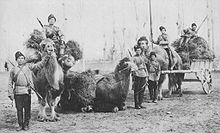- Orenburg Cossacks
-
Part of a series on Cossacks 
Cossack hosts Azov · Black Sea · Buh · Caucasus · Danube · Don · Volga · Ural · Terek · Kuban · Orenburg · Astrakhan · Siberian · Baikal · Amur · Semirechye · Ussuri · Zaporozhia Other groups Danube (Sich) · Tatar Cossacks · Nekrasov · Turkey · Jewish Cossacks History Registered Cossacks · Kosiński Uprising · Nalyvaiko Uprising · Khmelnytsky Uprising · Hadiach Treaty · Hetmanate · Colonisation of Siberia · Bulavin Rebellion · Pugachev's Rebellion · 1st Cavalry Army · Decossackization · Betrayal · XV SS Cossack Cavalry Corps · 1st Cossack Division Famous Cossacks Bohdan Khmelnytsky · Petro Sahaidachny · Ivan Vyhovsky · Petro Doroshenko · Ivan Mazepa · Ivan Sirko · Yemelyan Pugachev · Stenka Razin · Yermak Timofeyevich Cossack terms Ataman · Hetman · Kontusz · Papakhi · Plastun · Szabla · Shashka · Stanitsa · Yesaul The Orenburg Cossack Host (Russian: Оренбургское казачье войско), a part of the Cossack population in pre-revolutionary Russia, located in the Orenburg province (today's Orenburg Oblast, part of the Chelyabinsk Oblast and Bashkortostan).
After having constructed fortifications around the future town of Orenburg in 1734, they officially founded it in 1735. For the purpose of defending the city and colonizing the region, The Russian government relocated the Cossacks from Ufa, Iset, Samara and other places and created the Orenburg non-regular corps in 1748. In 1755, a part of it was transformed into the Orenburg Cossack Host (or Voisko) with 2,000 men.
In 1773—1774, the Orenburg Cossacks took part in Yemelyan Pugachev's insurrection. In 1798, all of the Cossack settlements in the Southern Urals were incorporated into the Orenburg Cossack Host (except for the Ural Cossacks). A decree of 1840 established the borders of the Host and its composition (10 cavalry regiments and 3 artillery battalions). In the mid-19th century, the Cossack population of this region equaled 200,000 people.
The Orenburg Host participated in the Russo-Swedish War of 1788–1790, and later - in all of the wars that Russia waged in order to conquer Central Asia.
The Orenburg Host consisted of 2 districts, or okrugs (after 1878 - 3 departments, or otdels). In 1916, the Cossack population of this region equaled 533,000 people on a land of 7,45 million desyatinas. One desyatina equaled 2,7 acres (11,000 m²). In the peaceful years of the early 19th century, the Orenburg Cossack Host supplied 6 cavalry regiments, 3 artillery battalions, 1 cavalry battalion, 1 sotnya (100 men) of guards and 2 detached sotnyas. During World War I, the Orenburg Cossack Host supplied 18 cavalry regiments, 9,5 artillery battalions, 1 cavalry battalion, 1 sotnya of guards, 9 unmounted sotnyas, 7,5 reserve sotnyas and 39 detached and special sotnyas (the total of 27,000 men).
After the October Revolution of 1917, the leadership of the Orenburg Cossack Host under the command of Ataman Alexander Dutov fought against the Soviets. The poorer Cossacks joined the ranks of the Red Army. The 1st Orenburg Cossack Socialist Regiment took part in the Ural Army Campaign of 1918.
In 1920, the Orenburg Cossack Host ceased to exist due to its liquidation.
See also
- Nagaybaks - Tatar-speaking Cossacks, belonged to the Orenburg Host
References
- Petr I. Avdeev Istoricheskaya Zapiska ob Orenburgskom Kazach'em Voiske, 1904
Categories:- Cossack hosts
Wikimedia Foundation. 2010.

